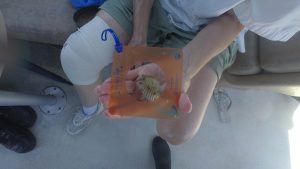Florida’s recreational scalloping season begins Saturday with shores off Dixie County and part of Taylor County opening for harvest and those along other Gulf Coast counties soon to follow.

This year, Florida Sea Grant (FSG) and the University of Florida’s Institute of Food and Agricultural Sciences (UF/IFAS) are introducing a newly designed orange and blue scallop sorting tool. The tool, free and available at select locations, is an orange acrylic square featuring a 2-inch diameter hole. A blue wristband helps secure the device. By comparing a scallop shell to the hole, harvesters can determine whether the size of their catch complies with sustainable practices.
Bay scallops live for about a year and a half. The animals’ peak reproduction period takes place during the fall — after harvest season — so small specimens are generally young animals that haven’t had the opportunity to spawn.
“Larger scallops have already reproduced, ensuring the next generation of scallops, which helps maintain a stable population,” said Victor Blanco, a Taylor County Extension agent with FSG and UF/IFAS. “Measuring scallop size ensures future harvests remain abundant, benefiting the long-term viability of the scallop fishery.”
Habitat loss, water quality issues and overharvesting have all contributed to scallop population depletion along Florida’s Gulf Coast.
In 2022, FSG collaborated with the Florida Fish and Wildlife Conservation Commission (FWC) to develop the first official scallop sorter, a clear square featuring a 1.5-inch hole. Feedback from harvesters subsequently led to the current iteration, which is easier to see underwater and helps preserve more scallops.
Although the FWC does not mandate that scallops reach a certain size before harvesting, the commission does limit how many gallons of scallop shells or scallop meat each person may collect in a day. The amount varies depending on location.
“For harvesters, targeting larger scallops means better quality and more meat to enjoy, as larger scallops are generally more desirable for consumers,” Blanco said. “By preserving smaller scallops, harvesters help secure the ecosystem’s health and their own future, balancing immediate enjoyment with long-term resource availability.”
In the Steinhatchee area, scallop sorters will be available at marinas, bait and tackle shops, restaurants, hotels, public boat ramps and businesses that are members of the Steinhatchee Chamber of Commerce. FSG and other stakeholders will also distribute them in Hernando and Taylor counties. Harvesters may contact their local FSG UF/IFAS county Extension agent for more information regarding availability.
Anyone unable to obtain an official sorter is encouraged to make one by cutting a ring out of 2-inc PVC pipe or simply to refer to the bottom of a soda can.
–Written with information supplied by Sarisha Boodoo, Florida Sea Grant science communicator. Learn more about the history of the UF/IFAS scallop sorter tool through Boodoo’s blog post.
###
Para accesar a esta comunicación en español, por favor utilice este enlace.
ABOUT UF/IFAS
The mission of the University of Florida Institute of Food and Agricultural Sciences (UF/IFAS) is to develop knowledge relevant to agricultural, human and natural resources and to make that knowledge available to sustain and enhance the quality of human life. With more than a dozen research facilities, 67 county Extension offices, and award-winning students and faculty in the UF College of Agricultural and Life Sciences, UF/IFAS brings science-based solutions to the state’s agricultural and natural resources industries, and all Florida residents.
ABOUT FLORIDA SEA GRANT
Hosted at the University of Florida, Florida Sea Grant is a partnership with the State University System of Florida, the State of Florida, and the National Oceanic and Atmospheric Administration that supports research, education and outreach to conserve coastal resources and enhance economic opportunities throughout the state.
flseagrant.org | @FloridaSeaGrant
 4
4
